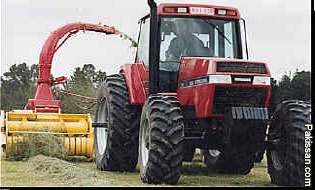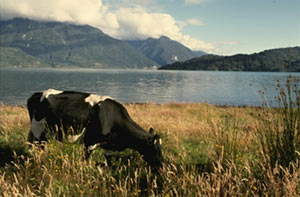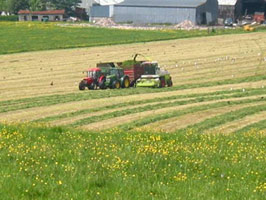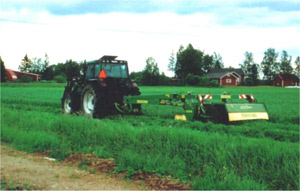|
Silage! A
Vital Solution of Fodder Scarcity in the Country
The critical constraint for profitable livestock production in
developing countries is the inadequacy of quality forage.
Because of ever growing human need for food, only limited
cultivated land can be allocated to fodder production. Due to
low per acre yield and minimum area under fodder production,
the available fodder supply is much less than actually needed.

This shortage in fodder supply is further being aggravated by
increased urbanization and enhanced shifting trend of
agriculture towards cash crops which further reduced the area
under fodder crops by 2% after each decade. Moreover in our
region, low per acre fodder yield coupled with two important
fodder scarcity periods (one during summer and other during
winter months), which, further aggravated the fodder
availability situations. Manipulating surplus fodder can go a
long way to bridge this wider gap between fodder supply and
demand during scarcity periods.
Improvement in quality and quantity of feeds could result in
the improvement of livestock pru p to 50% from existing
genetic potential of animals. So there is an immediate need to
explore the available feed resources for sustainable livestock
production and to suggest remedies to minimize the gap between
nutrients availability and requirements of animals. One of the
important feasible alternatives is to overcome the fodder
shortage during severe weather conditions or a prolonged
drought is the silage making of fodder when it is abundantly
available. Preservation of surplus fodder by silage making can
help reduce this irregular fodder supply pattern round the
year.
Non-leguminous crops like corn, oat, barley, mott grass and
jambo grass have relatively low buffering capacity and low
concentrations of fermentable carbohydrates. Leguminous crops,
on the other hand, have high moisture content, high buffering
capacity (due to high protein and mineral content) and
relatively low concentrations of fermentable carbohydrates
therefore, pH drop in leguminous crops is also slow.

Leguminous crops are extensively wilted prior to ensiling to
lower the moisture content either by field wilting or by the
addition of some absorbent. Dry roughages high in dry matter,
low in N content like wheat and rice straws can be added
successfully before ensilation. The information regarding the
nutritive value of Mott grass, Jambo grass, Berseem and
Lucerne plus wheat straw silage and its impact on lactation
performance of Nili-Ravi buffaloes is not available in the
literature.
The objective of the present project was to examine the
influence of various additives, moisture levels and
fermentation periods on nutritive value of leguminous (Berseem
and Lucerne) and non-leguminous (Jambo and Mott grass) fodders
and their silages and their influence on feed intake,
digestion kinetics, nutrient digestibility, milk yield and its
composition in lactating Nili-Ravi buffaloes.The hypothesis
was that silages of various fodders (Jambo, Mott, Berseem and
Lucerne) could successfully replace the conventional fodders
in buffalo diets without adversely affecting their lactation
performance.
The trials were conducted in three phases i.e. laboratory, in
situ and lactation performance phases. Samples of Jambo and
Mott grass fodders harvested at 50 days of maturity were
analyzed for dry matter (DM), crude protein (CP), neutral
detergent fiber (NDF), acid detergent fiber (ADF), acid
detergent lignin (ADL), hemicellulose, cellulose and ash
contents. Jambo and mott grasses were ensiled in laboratory
silos using two silage additives, molasses and crushed corn
grains at 2, 4 and 6% of forage DM. The material in these
silos was allowed 30, 35 and 40 days fermentation periods.
While, berseem and lucerne fodders harvested at one tenth
bloom were ensiled in laboratory silos at 20, 30, 40% DM and
fodder as such (without wheat straw) each with three levels of
molasses as additive i.e. 2, 4 and 6% of forage DM. Wheat
straw was added in different proportions to increase DM of
leguminous fodders. After opening these silos, the pH and
lactic acid concentration were measured and thereafter these
silages were subjedto complete chemical analysis.

Jambo grass ensiled with 2% molasses for 30 days proved to be
the best as evidenced by low pH value and high lactic acid
concentration. The pH of all treatments ranged from 3.50 to
3.90 while, the lactic acid concentration ranged from 3.86 to
4.10% but the results were non-significant statistically.
These results showed that fermentation was predominantly of
lactic acid an indication of well-preserved and good quality
silage. Dry matter, TP, NDF and hemicellulose values were
significantly affected by additive type being better with
molasses at 2% level. There was non-significant change in CP,
ADF, ADL, cellulose and ash contents during ensiling of jambo
grass. At all inclusion levels of corn and molasses,
fermentation periods did not affect the results. However,
results indicated that preservation of jambo grass was
comparatively better with a little loss of nutrients when it
was ensiled with 2% molasses for 30 days. The pH and lactic
acid of mott grass ensiled with molasses and corn at all
inclusion levels and fermentation periods were non-significant
across all treatment means. Similarly, DM, CP, TP, ash and
cell wall fractions (NDF, ADF, ADL, hemicellulose and
cellulose) of mott grass silage remained unaffected by
additives, their levels and fermentation periods. These
results revealed that hydrolysis of fermentable carbohydrates
from both the additives were similar during ensilation of mott
grass. Therefore, being economical mott grass ensiled with 2%
molasses for 30 days was selected for subsequent
investigations.
Lactic acid and pH values of berseem ensiled at various DM
contents with all inclusion levels of molasses were
non-significant across all treatment means. Dry matter, CP,
ash and cell wall fractions (NDF, ADF, hemicellulose,
cellulose and ADL) were significantly affected by DM content
at ensiling. However, the effect of additive levels and the
interaction between additive levels and DM content were
non-significant statistically. Regardless of additive levels,
results were significantly better for berseem ensiled at 30%
DM.
Non-significant results of pH and lactic acid of lucerne
silage revealed that all the silages were preserved well in
small-scale laboratory silos. Dry matter, CP, NDF, ADF,
hemicellulose, cellulose, ADL and ash contents of lucerne
silage were significantly affected by DM content at ensiling
while, the affect of additive levels and DM at ensiling were
non-significant. However, the results of chemical composition
were comparatively better when lucerne was ensiled at 30% DM
with 2% molasses.
For in situ digestion kinetics studies, a male buffalo bull
fitted with ruminal cannula was used of each study. Nylon bags
measuring 10 23 cm with an average pore size of 50Ám were used
for determination of digestion kinetics. These bags separately
contained 10g samples of Jambo and Mott grass harvested at 50
days of maturity, Berseem and Lucerne fodders harvested at one
tenth bloom and their best screened silages from laboratory
studies. For each time point, there were three bags for each
sample. Two bags were used to determine DM and NDF
degradabilities while third was kept as a blank. These bags
were exposed to ruminal fermentation for 1, 2, 4, 6, 10, 16,
24, 36, 48 and 96 hours. After removal from the rumen,
residues in the bags were analyzed for DM and NDF.
Dry matter and NDF degradabilities (at 48 hours of incubation)
of jambo and mott grasses were significantly higher (p<0.05)
than that of their respective silages. Dry matter and NDF
degradabilities of berseem and its silage were non-significant
different. However, DM degradabilities of lucerne and its
silage were non-significant but NDF degradability of lucerne
was significantly higher than that of its silage. Dry matter
and NDF lag time, rate and extent digestion of jambo grass,
mott grass, berseem and lucerne were non-significant across
their respective silages. The results showed that all the
silages were preserved well with minimum loss of soluble
carbohydrates and ensilation rather improve their
digestibility.For lactation trials each non-leguminous fodder
(jambo and mott grasses) was ensiled with 2% molasses for 30
days on large scale in bunker silos. While, each leguminous
fodder (berseem and lucerne) was ensiled at 30% DM with 2%
molasses. Wheat straw was added to reduce moisture content of
leguminousfodders.

Fifteen, early lactating Nili-Ravi buffaloes, five animals in
each group, were employed in a Completely Randomized Design
for each leguminous and non-leguminous study. Three
experimental iso-nitrogenous and iso-caloric diets were
formulated that contained 75% of jambo grass (control), jambo
grass silage or mott grass silage and 25% concentrate for
non-leguminous fodders. While in case of leguminous fodders,
diets contained 75% of berseem fodder (control), berseem or
lucerne silage and 25% concentrate. The buffaloes were fed for
60 days at ad libitum intakes. First 10 days were allowed for
dietary adaptation and 50 days were for sample collection.
Milk samples (a.m. & p.m.) were collected daily during the
last 7 days of feeding trial and were analyzed for CP, fat,
solid not fat and total solids. During last week of the study,
a digestibility trial was conducted. The acid insoluble ash
was used as digestibility marker. Intake of DM was the highest
(13.3 kg/d) in animals fed jambo grass (control) diet followed
y those fed jambo grass silage (12.5 kg/d) and mott grass
silage (12.03) diets. The difference in DMI was significant
across fodder and silage based diets but the difference was
non-significant across both silage-based diets. The depression
in DMI may be attributed to the presence of fermentation
products in the silage. However, DMI as a percent of body
weight was non-significant across all treatments. Crude
protein intake showed a similar trend across all treatments as
was observed in DMI. Intake of NDF (NDFI) was significantly
higher (8.35 kg/d) in buffaloes fed jambo grass diet followed
by those fed mott grass silage (7.99 kg/d) and jambo grass
silage (7.32 kg/d) diets. Similar trend was also noted for NDF
intake as percent of body weight and digestible NDF intake
across all diets. The apparent digestibilies of DM, CP and NDF
did not show any treatment effect.
Dry matter intakes by lactating buffaloes differed
significantly across berseem fodder (control), lucerne silage
and berseem silage diets. Intake of DM was higher (13.8 kg/d)
in animals fed berseem fodder (control) diet followed by those
fed lucerne silage (12.5 kg/d) and berseem silage (11.9
kg/day) diets. However, DMI as a percent body weight was
higher (3.24) in animals fed berseem fodder diet followed
those fed lucerne silage (2.89) and berseem silage (2.63)
diets. The difference in DMI percent body weight was
significant across fodder and silage based diets while these
results were non-significant across both silage-based diets.
Digestible DMI also followed the similar trend as was observed
in DMI which was higher (8.95 kg/day) in animals fed berseem
fodder diet followed by those fed lucerne silage (7.94 kg/day)
and berseem silage (7.39 kg/day) diets. Similarly, CP intake
and digestible CP intake also showed a similar trend as was
observed in DMI and digestible DMI across all treatments.
Intake of NDF wsthe highest (5.68 kg/d) in buffaloes fed
berseem fodder diet followed by those fed lucerne silage (5.50
kg/d) and berseem silage (5.00 kg/d) diets. Thedifference was
significant across fodder and silage based diets but NDFI was
non-significant across both silage-based diets. Similar trend
was also noted for NDF intake as percent body weight and
digestible NDF intake across all diets. The apparent DMD was
the highest (64.8%) in animals fed berseem fodder diet
followed by those fed lucerne silage (63.4%) and berseem
silage (62.0%) diets. The apparent DMD was statistically
significant across fodder and silage based diets but DMD was
non-significant across both silage-based diets. However,
apparent CP and NDF digestibilities remained unaltered across
all treatments.
Milk yield (4% FCM) was non-significant in animals fed
leguminous and non-leguminous fodders and their silages. Milk
fat, total solids, solid not fat, milk CP, TP and NPN values
also remained unaltered in animals fed non-leguminous fodder
or silage diets. These results may be attributed to
insignificant variation in DMI percent body weight and
nutrient digestibility in animals fed all experimental diets.
However, milk fat and total solids were significantly higher
in animals fed berseem silage and lucerne silage diets as
compared to those fed berseem fodder (control) diet. It was
attributed to increased intake of structural carbohydrates,
which were degraded by cellulolytic microbes for the
production of acetate and milk fat. However, milk CP, TP, NPN
and solid not fat values did not show any treatment effect.
Grasses and legumes were ensiled with different additives at
various moisture levels for various fermentation periods, 2%
molasses proved to be best additive at 30% DM for 30 days.
When these silages were subjected to lactation performance
study it was revealed that despite low feed intake of silage
there was not any depression in milk yield and its
composition. So replacing fodder with silage no adverse effect
was noted on the performance of lactating buffaloes. Thus
silage making of surplus fodders during their abundant growth
period will not only help overcome the irregular fodder supply
pattern, one of the major culprit for lower ruminant
productivity, but it will also enhance fodder yield of
multicut fodder crops by increasing their number of cuts.
Nasir Ali Tauqir and Dr. Muhammad Sarwar,
Institute of Animal Nutrition and Feed Technology, University
of
Agriculture, Faisalabad
|
Pakissan.com;
|